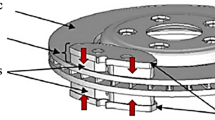Abstract
The squeal noise occurring from the disc brakes of passenger cars has been analyzed by using the complex eigenvalue method numerically. The contact between a disc and two pads was analytically modeled as many linear springs and dampers in an effort to develop the improved equation of motion derived on the basis of Lagrange’s equation and the assumed mode method. The finite element modal analysis results for disc brake components constitute an eigenvalue matrix in the analytical equation of motion. The complex eigenvalue analyses based on the equations of motion are able to examine the dynamic instability of a brake system, which is an onset of squeal, by considering the disc rotational effect. Numerical analyses showed that the modes unstable in an undamped analysis became stable in a damped case, which illustrates the important effect of damping on the squeal instability in a brake squeal simulation. Then several modified brake models were suggested and investigated how effectively they suppressed the occurrence of squeal noise. The brake parts such as a pad chamfer and a disc vane were modified and the influence of pad chamfer and vane shapes on squeal occurrence was proved to be significant. The numerical results showed that proper structural modification of a disc brake system can suppress the brake squeal to some extent.
Similar content being viewed by others
References
Cantoni C., Cesarini R., Mastinu G., Rocca G. and Sicigliano R. (2009). Brake comfort A review. Vehicle System Dynamics 47, 8, 901–947.
Dai Y. and Lim T. C. (2008). Suppression of brake squeal noise applying finite element brake and pad model enhanced by spectral-based assurance criteria. Applied Acoustics 69, 3, 196–214.
Flint J. and Hulten J. (2002). Lining-deformation-induced modal coupling as squeal generator in a distributed parameter disc brake model. J. Sound and Vibration 254, 1, 1–21.
Guan D. H. and Jiang D. Y. (1998). A study on disc brake squeal using finite element methods. SAE Paper No. 9805-7.
Guan D. and Huang J. (2003). The method of feed-in energy on disc brake squeal. J. Sound and Vibration 261, 2, 297–307.
Heilig J. and Wauer J. (2003). Stability of a nonlinear brake system at high operating speeds. Nonlinear Dynamics 34, 3, 235–247.
Kang, J. (2010). Mode shape variation of disc brake with respect to contact stiffness variation. Trans. Korean Society of Automotive Engineers 18, 3, 127–132.
Kang J., Krousgrill C. M. and Sadeghi F. (2008). Dynamic instability of a thin circular plate with friction interface and its application to disc brake squeal. J. Sound and Vibration 316, 1, 164–179.
Kang J., Krousgrill C. M. and Sadeghi F. (2009a). Comprehensive stability analysis of disc brake vibrations including gyroscopic, negative friction slope and mode-coupling mechanisms. J. Sound and Vibration 324, 1, 387–407.
Kang J., Krousgrill C. M. and Sadeghi F. (2009b). Analytical formulation of mode-coupling instability in disc-pad coupled system. Int. J. Mechanical Sciences 51, 1, 52–63.
Kang, J. Y. (2009). Squeal analysis of gyroscopic disc brake system based on finite element method. Int. J. Mechanical Sciences 51, 4, 284–294.
Kinkaid N. M. and O’Reilly O. M. (2003). Automotive disc brake squeal. J. Sound and Vibration 267, 1, 105–166.
Kung S., Dunlap K. B. and Ballinger R. S. (2000). Complex eigenvalue analysis for reducing low frequency brake squeal. SAE Paper No. 2000-01-0444.
Lanchester, F. W. (1902). Improvements in the Brake Mechanism of Power-propelled Road Vehicles. G.B. Patent No. 264-7.
Lee, H. W. (2000). An Optimal Design Method for Brake Squeal Noise based on Complex Eigenvalue and Sensitivity Analyses and Response Surface Methodology. Ph. D. Dissertation. University of Michigan. Ann Arbor, MI, USA.
Liles, G. D. (1989). Analysis of disc brake squeal using finite element methods. SAE Paper No. 89110.
Mohammed A. Y. and Rahim I. A. (2013). Analysing the disc brake squeal: Review and summary. Int. J. Sci. Tech. Research 2, 4, 60–72.
Nack, W. V. (2000) Brake squeal analysis by finite elements. Int. J. Vehicle Design 23, 3/4, 263–275.
North, M. R. (1976). Disc brake squeal. In: Braking of road vehicles. Automobile Division of the Institution of Mechanical Engineers, 169–176.
Ouyang H., Nack W., Yuan Y. and Chen F. (2005). Numerical analysis of automotive disc brake squeal: A review. Int. J. Vehicle Noise and Vibration 1, 3/4, 207–231.
Ouyang H. and Mottershead J. E. (2005). Dynamic instability of an elastic disk under the action of a rotating friction couple. J. Applied Mechanics 71, 6, 753–758.
Shin K., Brennan M. J., Joe Y. G. and Oh J. E. (2004). Analysis of disc brake noise using a two-degree-offreedom model. Int. J. Automotive Engineering 5, 1, 61–67.
Shin K., Brennan M. J., Oh J. E. and Harris C. J. (2002). Analysis of disc brake noise using a two-degree-offreedom model. J. Sound and Vibration 254, 5, 837–848.
von Wagner U., Hochlenert D. and Hagedorn P. (2007). Minimal models for disk brake squeal. J. Sound and Vibration 302, 3, 527–539.
Author information
Authors and Affiliations
Corresponding author
Rights and permissions
About this article
Cite this article
Kim, C., Zhou, K. Analysis of automotive disc brake squeal considering damping and design modifications for pads and a disc. Int.J Automot. Technol. 17, 213–223 (2016). https://doi.org/10.1007/s12239-016-0021-1
Received:
Revised:
Accepted:
Published:
Issue Date:
DOI: https://doi.org/10.1007/s12239-016-0021-1



